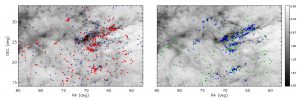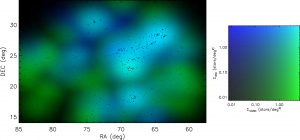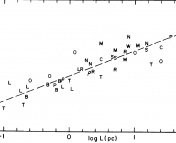Title: The Greater Taurus–Auriga Ecosystem. I. There is a Distributed Older Population
Authors: A.L. Kraus, G.J. Herzig, A.C. Rizzuto, and others.
First Author’s Institution: University of Texas at Austin
Status: Published in ApJ [open access]
Introduction
If only our eyes were sensitive enough, the night sky would be ablaze with nearby astronomical structures. The Andromeda Galaxy would stretch across the sky about six times the angular width of the full Moon. The Magellanic Clouds would be fireballs tens of Moons across. The reddened molecular filaments of the nearby star-forming region Taurus-Auriga, glittering with young stars, would stretch over an area about 30 Moons across.
Taurus-Auriga is almost too close to us for its own good. It’s the nearest substantial star-forming region, lying only 145 pc (about 470 light-years) away. Much of it is extremely young, perhaps less than 5 Myr old. Its age is invaluable for studying star formation, but its size across the sky makes it a tricky business to make a full accounting of its members. But this accounting is unavoidable if we want to establish, among other things, the timescales of star formation or molecular cloud dissipation, and the system’s initial mass function (IMF).
Young circumstellar disks re-emit stellar light in the infrared, because the disks behave roughly like a blackbody at a temperature cooler than the host star. This “infrared excess” makes young stars with disks relatively easy to identify with infrared photometry. Indeed, the Wide-field Infrared Survey Explorer (WISE) mission has gone a long way to painting in the population of Taurus-Auriga stars which possess disks. But disk-less stellar members of Taurus are much more poorly quantified. Which stars separated by entire degrees are associated?
In fact, previous attempts suggest that the Taurus IMF is a bit weird, because it’s heavy on the low-mass end. Is this indicative of deeper physics of the star formation process? Or are we just being hoodwinked and bamboozled by a masquerade of stellar interlopers? How are we to tell apart Taurus-Auriga’s serious card-carrying members from the masked ball of harlequins and mountebanks? At 30 Moons across, it’s quite a carnival.

Fig. 1: Left: The author’s sample of candidate disk-less stars in Taurus. Likely members are red, likely nonmembers blue. Right: All likely members that have disks (blue) and don’t (green). The greyscale indicates dust extinction. Note the stars that have disks tend to concentrate around the dusty filaments. Note also that the full Moon is about the size of one of the zeros on the axes. (Figs. 1 and 8 in today’s paper.)
Ferreting out the interlopers
The authors of today’s paper began by dredging the literature for a long list of all possible diskless Taurus members, as suggested by previous studies (Fig. 1, left). They then applied multiple criteria for deciding whether they are Taurus members or not. Here’s a table of them:
| Criterion | Reasoning | Possible complications |
| Kinematics | Young stellar siblings will tend to move in a co-moving crowd | Stellar activity or binary systems have give misleading radial velocities |
| HR diagram position | Co-eval stars will reside on isochrones. | There may be a prolonged period of star formation, or other field star contaminants may be passing through. |
| H-alpha emission | Young stars will emit H-alpha due to accretion and chromosphere activity | Older stars which rotate rapidly may emit H-alpha. |
| Lithium abundances | Lithium is quickly burned away in late-K and M stars, so its presence is a marker of youth | Older members that have already burned it away are indistinguishable from many non-members, and F-G stars keep their lithium longer. |
| Surface gravity | Surface gravity via sodium doublet lines indicate stars are still contracting |
Interlopers may slip through any one of these criteria, but by applying all of them, this possibility is minimized. In addition to literature searches, the authors acquired values for some of these criteria by taking spectra of some of candidates with a 2.2-m telescope on Mauna Kea.
The criterion of kinematics was the last to be applied. The authors’ reasoning was that, if members’ projected radial velocities and proper motions—Taurus-Auriga is so close to us and is so extended that the motions of widely separated members will exhibit perspective effects—translated into absolute velocities that are close to the average velocity of Taurus around the center of the Milky Way, then they can be considered members.

Fig. 2: A representation of the Taurus stars in terms of disk fraction (color; see color key on the right) and density of stars (color brightness). From this you can see that there are dense (i.e., bright) agglomerations of stars with and without disks, surrounded by an extended low-density (i.e., dark) region of mostly disk-less stars. Compare this plot to Fig. 1. (Fig. 9 in today’s paper.)
Disky stars tend to clump
In the end, they found their sample to contain 218 “confirmed or likely” members, and 160 stellar charlatans (Fig. 1, right). Interestingly, between angular scales of 0.03 and 3 degrees, the level of spatial clustering is the same among disk-hosting and disk-less stars. But disky stars tend to cluster more at separation scales of <0.03 degrees, and disk-less stars are more common at scales of >10 degrees. This means that, in addition to the disk-hosting stars which tend to clump in the molecular clouds, there is a widely-distributed pall of other member stars (Fig. 2). Based on their disk-hosting fractions, it appears that the more widely-distributed ones could be ~10 Myr old— still very young for a star, but older than the disky stars. In fact, three-quarters of Taurus stars appear to be disk-less.
Have disk-less stars blown off their surrounding gas, or have they been dynamically sprayed out of denser regions? The authors cannot answer this, but they point out that the precise parallaxes and proper motions from Gaia may help. In any case, it appears that star formation in Taurus-Auriga took place over an extended timescale. How much does the low-mass-heavy IMF of Taurus-Auriga change? The answer is… not a whole lot. But the authors also note that there may yet be more members out there, including early-type stars. In fact, more member candidates were found while this paper was going through peer review.
The authors finish with some arguments based on the spatial distribution of the kinematics to suggest that the star formation of Tauris-Auriga may just be a component part of a still grander star formation history over an even larger swathe of the sky. Be on the lookout for Gaia papers that will help us piece more of this history together.




